Occupational Environment Monitoring at the Pallet Manufacturing Plant
99,000 ₫
Note: The above price is calculated for one sample, and the price may vary depending on the area of the environment to be monitored and market fluctuations. For more accurate pricing support, please refer to the quotation table or contact our consulting staff directly.
Occupational environment monitoring at a pallet manufacturing plant is a process of collecting, analyzing, and evaluating workplace factors that may harm workers’ health.
Table of Contents
Toggle1. Overview of Pallet Manufacturing Factory
a. What is a pallet manufacturing factory?
Manufacturing factory for pallets is a production facility specializing in producing pallets, which are platforms or bases used to hold and transport goods during shipping and storage. Pallets are made from materials such as wood, plastic, metal, or composite, and are designed to support and protect goods during movement by forklifts or other transportation vehicles.

b. Production stages in a pallet manufacturing factory
Pallet manufacturing factories generally include the following production stages:
- Material preparation: The factory collects and prepares the necessary materials such as wood, plastic, metal, or composite for pallet production.
- Material processing and cutting: Materials are processed and cut into separate parts according to the pallet’s size and design.
- Assembly and shaping: Pallet components are assembled and shaped into the final pallet form and dimensions.
- Quality inspection: Completed pallets are inspected to ensure compliance with durability standards and load-bearing requirements.
- Packaging and shipping: After quality inspection, pallets are packaged and prepared for delivery to customers or distributors.

c. Types of machinery used in a pallet manufacturing factory
Pallet manufacturing factories use various machinery and equipment for the production process. Some common machines used include:
- Saws: Used to cut wood or composite materials into separate parts according to pallet dimensions and design.
- Sanders: Used to smooth and finish the surface of pallet components.
- Lathes: Used to process wood or metal parts to form pallet components.
- Press machines: Used to compress and assemble pallet components into finished pallets.
- Welding machines: Used to weld metal or plastic parts of pallets together to ensure strength and load-bearing capacity.
- Printing machines: Used to print information, brand labels, or barcodes on the pallet surface.
- Packaging machines: Used to package pallets after completion before shipping.
- Lifting machines: Used to lift and move pallets during production and transportation.

d. Occupational diseases for workers in a pallet manufacturing factory
Workers in pallet manufacturing factories may face some occupational diseases related to their work. Common occupational diseases in the pallet production industry include:
- Respiratory diseases: Exposure to dust, fumes, or smoke from cutting, sanding, and processing wood can cause pneumonia, rhinitis, sinusitis, or other respiratory problems.
- Skin diseases: Contact with chemicals, oils, or wood materials may cause skin irritation, dermatitis, infection, eczema, or allergies.
- Musculoskeletal diseases: Activities such as cutting, lifting, pulling, and transporting pallets can strain bones, muscles, and joints, leading to arthritis, back pain, joint degeneration, or injuries.
- Hearing-related diseases: Noise from machinery, tools, or production processes can damage hearing, causing hearing loss, tinnitus, or other ear-related issues.
- Hand and neck disorders: Activities like cutting, processing, and assembling pallets may stress the muscles, tendons, and ligaments in hands and neck, causing cervical spine degeneration, muscle inflammation, or musculoskeletal injuries.
To prevent occupational diseases, labor protection measures must be applied, including the use of personal protective equipment (such as respirators, safety glasses, gloves), ensuring proper ventilation in the factory, providing occupational safety training, and conducting regular health checks for workers.

e. Common types of pallets on the market
There are many common types of pallets on the market depending on their use and material. Some popular types include:
- Wooden pallets: Made of wood, widely used in industry. Two main types are pressed wood pallets and solid wood pallets.
- Plastic pallets: Made from plastic materials, such as composite, recycled, or new plastic. Plastic pallets have high durability, can withstand temperature and humidity, and are easy to clean.
- Metal pallets: Made of steel or aluminum alloys, these have high strength, can carry heavy loads, and are suitable for applications requiring durability and long lifespan.
- Cardboard pallets: Made of cardboard or paperboard, these are lightweight and suitable for transporting light goods without requiring high load capacity.
- Composite plastic pallets: Combine plastic with fiberglass or carbon fiber, providing high strength, load capacity, and lightweight properties.
- Wood-plastic composite pallets: Combine wood and plastic, offering wood durability and water resistance, suitable for humid environments.
2. Overview of Workplace Environmental Monitoring Services
a. What is workplace environmental monitoring in pallet manufacturing factories?
Workplace environmental monitoring (or occupational environment measurement) in pallet manufacturing factories involves collecting, evaluating, and analyzing measurements of workplace environmental factors to take timely actions, minimize environmental harm to workers’ health, and prevent occupational diseases. Environmental monitoring is mandatory for pallet manufacturing factories.
Workplace environmental monitoring is crucial for caring for, protecting, and enhancing worker health because workers are the primary resource of a business and directly generate profits. Workers frequently exposed to hazardous factors above allowed standards may suffer health impacts and occupational diseases.
REGISTER WORKPLACE ENVIRONMENTAL MONITORING SERVICE
b. Nam Viet workplace environmental monitoring program
Nam Viet’s workplace environmental monitoring program is developed by monitoring engineers in occupational safety and environmental protection. To ensure worker health and safety, this program uses modern measurement methods to monitor air quality, water, microclimate, physical factors, dust, and other workplace elements. This program is essential for ensuring a safe working environment and protecting worker health.
Additionally, Nam Viet’s program plays a crucial role in researching and developing new solutions to improve workplace environmental quality. With the dedication and professionalism of monitoring experts, Nam Viet’s exclusive monitoring program is a breakthrough in occupational safety and environmental management in Vietnam.

c. Standardization in workplace environmental measurement procedures
Standardization in Nam Viet’s workplace environmental measurement procedures is vital to ensure accurate and reliable results. The program uses recognized standards and standardized procedures from Ho Chi Minh City Department of Health. This ensures that collected data is highly reliable for assessing workplace environments and making decisions to improve working conditions and protect worker health.
These standardized procedures also ensure that measurements are conducted by highly qualified monitoring specialists with years of experience, helping managers and experts trust An Toàn Nam Việt’s results and make accurate, valuable decisions for protecting worker health and the environment.
By applying standardized measurement procedures, Nam Viet demonstrates its commitment to providing a safe work environment and protecting worker health, while contributing positively to improving occupational safety and environmental management in Vietnam.
d. Workplace environmental monitoring report for pallet manufacturing factories
Monitoring results are prepared according to Form 04, Appendix III issued with Decree 44/2016/ND-CP and made in 02 copies: one sent to the contracted enterprise and one kept at the monitoring organization.
The retention period for workplace environmental monitoring results is unlimited according to law.

e. Frequency of workplace environmental monitoring according to law
According to Clause 2 of Article 18, Law on Occupational Safety and Hygiene 84/2015/QH13, employers must organize workplace environmental monitoring to evaluate harmful factors at least once a year.
f. Deadline for submitting workplace environmental monitoring reports according to law
The deadline for submission is before December 31 annually. Enterprises in production facilities must submit workplace environmental monitoring results to the Department of Health at the locality where the production or business facility is headquartered and where employees are working.
When there are changes in technology, production processes, or during renovation or upgrading that may generate new hazardous factors for worker health, enterprises must update occupational hygiene records related to harmful factors requiring environmental monitoring.
g. Penalties for violations of workplace environmental monitoring by employers
According to Article 27 of Decree No. 12/2022/ND-CP dated January 17, 2022, regulating administrative penalties in labor, social insurance, and Vietnamese workers working abroad under contracts:
- Clause 2: A fine of VND 2,000,000 – 5,000,000 for employers who do not publicly inform employees at the monitoring site and workplaces about monitoring results and evaluation of hazardous factors immediately after obtaining them.
- Clause 3: A fine of VND 20,000,000 – 40,000,000 for employers who fail to conduct workplace environmental monitoring to control harmful effects on worker health as required by law.
- Clause 4: A fine of VND 40,000,000 – 60,000,000 for employers who cooperate with monitoring organizations to commit fraud in workplace environmental monitoring, but not to the extent of criminal liability.
3. Harmful Environmental Factors for Workers in Pallet Manufacturing Plants
In pallet manufacturing plants, there are several environmental factors that can be harmful to workers. The main factors include:
- Dust and particles: The pallet production process can generate wood dust or particles from other materials, posing a risk of inhalation or entry into the respiratory system. Prolonged exposure to dust and particles can lead to health issues such as pneumonia, respiratory allergies, and occupational lung diseases.
- Chemicals: Pallet production may involve chemicals such as glue, adhesives, or surface coatings. Exposure to these chemicals can cause skin, eye, and respiratory irritation, as well as other health issues such as allergies and organ damage.
- Noise: Machinery and production processes in pallet factories can generate high noise levels. Prolonged and continuous noise can cause hearing problems, fatigue, stress, and negatively affect workers’ overall health.
- Temperature and humidity: The working environment in pallet manufacturing plants may have high temperature and humidity due to machinery operation and production processes. Uncomfortable temperature and humidity conditions can cause heat stress and discomfort for workers.
- Physical activity and work posture: Workers in pallet factories often perform physical activities such as lifting, pulling, and moving pallets. Repetitive movements and awkward work positions can lead to musculoskeletal injuries, muscle strain, and posture-related issues.
REGISTER FOR OCCUPATIONAL ENVIRONMENT MONITORING SERVICE
4. Measures to Improve the Working Environment in Pallet Manufacturing Plants
To improve the working environment in pallet factories and protect workers’ health, the following measures can be applied:
- Occupational safety and health management system: Ensure that the plant has an effective safety and health management system. This includes establishing safety procedures and regulations, complying with occupational safety standards, and providing sufficient safety information and training for employees.
- Risk assessment and control: Conduct labor risk assessments in the factory and identify control measures to minimize hazards. This includes handling and removing pollution sources, reducing noise, providing effective dust extraction systems, and using personal protective equipment such as masks and safety gear.
- Ventilation and exhaust systems: Ensure effective ventilation systems to remove dust and harmful fumes from the air. Use exhaust fans or dust extraction systems to eliminate dust and waste from production processes.
- Training and education: Provide training and education on occupational safety, environmental protection, and health for all employees. Ensure that everyone understands and follows safety rules, uses protective equipment correctly, and knows how to safely handle waste and chemicals.
- Work adjustment and organization: Design work tasks and organize workflows to suit workers’ health. Adjust work processes, arrange workspace layout, and manage work hours to minimize injury risks and stress.
- Regular monitoring and evaluation: Conduct periodic monitoring and evaluations to ensure compliance with safety and health rules. Inspect equipment, systems, and the work environment to detect issues early and implement corrective measures.
- Encouraging participation and feedback: Promote employee participation and feedback. Create a workplace culture that enhances awareness and commitment to safety and health, while listening to suggestions for environmental improvements.
- Periodically conduct occupational environment monitoring in factories, collect and analyze harmful factors affecting workers, and make adjustments to reduce risks and prevent occupational diseases.
5. Benefits of Periodic Monitoring in Pallet Manufacturing Plants
An Toan Nam Viet provides enterprises with excellent benefits when using occupational environment monitoring services according to Decree 44/2016/ND-CP on managing and controlling harmful factors in the working environment affecting employees.
- Enterprises can proactively control harmful factors in workshops or factories.
- Receive advice and recommendations on measures to minimize harmful factors and improve the working environment.
- Indirectly protect human resources, the key factor in business development.
- Reduce the impact of occupational diseases on health, lowering future treatment costs.
- Improve workers’ health, ensuring product quality and maintaining production output.
- Comply with occupational safety laws, avoiding legal risks.
- Enhance credibility and professionalism in all aspects, elevating the enterprise’s brand.
Nam Viet’s environmental monitoring service is a solution to minimize occupational disease risks, contributing to a clean and high-quality working environment.

6. Nationwide Occupational Environment Monitoring Center
The Occupational Environment Monitoring Center of Nam Viet is a professional unit specializing in supervising and measuring occupational environment quality across all provinces in Vietnam. With a team of experienced monitoring specialists, the center uses modern measurement equipment to ensure accuracy and reliability.
In addition to providing monitoring services, the center assists clients in planning, handling, and tracking occupational environment issues. With the motto “customers at the center,” the center prioritizes client satisfaction, meets all client needs, and commits to providing the best solutions for businesses.
REGISTER FOR OCCUPATIONAL ENVIRONMENT MONITORING SERVICE
With investments in technology, equipment, and personnel, Nam Viet’s monitoring center has become a reputable unit in occupational environment monitoring in Ho Chi Minh City, with the following objectives:
- We always value brand reputation and service quality.
- We provide clients with the best and most suitable solutions possible.
- Alongside a team of experienced Masters and Engineers committed to environmental protection and business benefit.
- By working with Nam Viet Environmental Monitoring, your company will receive professional service from field experts and enjoy the best cost advantages.
The occupational environment monitoring process at Nam Viet includes the following basic steps:
- Before monitoring, we ensure that all equipment is calibrated according to legal regulations.
- Strictly follow the occupational environment monitoring procedures committed to the Department of Health.
- Report monitoring results honestly to the employer.
- If results indicate unsafe conditions for workers, Nam Viet provides solutions, and the workplace will:
- Implement measures to improve working conditions to minimize harmful effects and prevent occupational diseases.
- Organize health examinations to detect occupational and work-related diseases early for employees in unsafe positions.
- Provide material compensation for workers according to labor law regulations.

7. Occupational Environment Monitoring Pricing
To help enterprises conduct professional and effective occupational environment monitoring, Nam Viet provides customers with a detailed and reasonably priced service quotation.
- Our pricing table provides detailed information on the costs of monitoring services, including travel, measurement, analysis, and reporting fees. Clients can rely on the accuracy and reliability of our monitoring reports.
- We commit to offering the most competitive and reasonable prices on the market and are always ready to provide fast and professional consultation on monitoring services.
- With Nam Viet’s quotation table, clients can easily select service packages that suit their needs. We guarantee maximum satisfaction with our professional service quality.
No comments yet

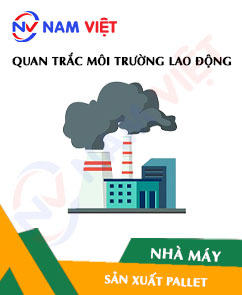
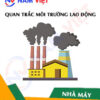
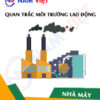
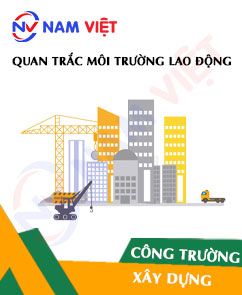


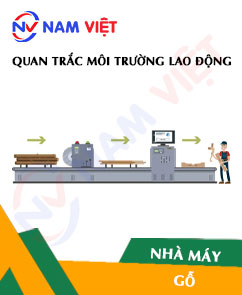
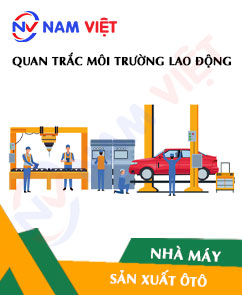
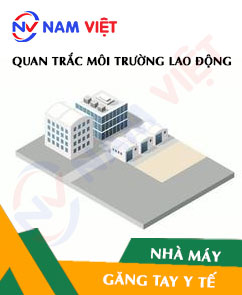


Review Occupational Environment Monitoring at the Pallet Manufacturing Plant
There are no reviews yet.